- La Feria Community Holds Succesful Business Mixer Event
- Little Nashville to Take Place in Downtown Mercedes
- Lions Basketball Captures District Gold
- La Feria ISD Students Compete in Regional Chess Tournament
- Lions End First Half of 32-4A on a High Note
- La Feria ISD Held Another Successful Parent Conference
- Strong Appearance for Lions at Hidalgo Power Meet
- LFECHS Students Get to Meet Local Actress
- Students Participate in Marine Biology Camp
- Two LFECHS Students Qualify for All-State Band
Primera Celebrates 60 Years of Progress
- Updated: May 15, 2015
“First in the Hearts of Many”

Bill Keltner
The city of Primera turned out in great numbers last month to cheer the downtown parade marking their 60th year as a town. The city fathers staged undoubtedly the biggest event in their entire history, and said later that “everybody had a “far out time.” according to city official Veronica Flores. “Primera is growing with the times, and we’re on the move.“
However, the real age of this frontier Texas community traces back over 100 years. To learn the interesting history of this proud little town just five miles northwest of Harlingen, LA FERIA NEWS talked with a number of officials and pioneer citizens at their beautiful new City Hall.
We are indebted to Primera Mayor Pat Patterson, Mayor Pro Tempore David Osborne, City administrator Javier Mendez, and Alderman Joe Ramirez for information about the history of the city. Special thanks go to Norman Rozeff of the Harlingen Historical Preservation Society for the historical background of the city.
During its 100 years of existence, PRIMERA has had many fathers: Many entrepreneurs came to town to make their fortunes; some succeeded; others failed. Several of the early developers names are still to be seen on the streets and subdivisions: Names like: Wilson, Autrey, King, J.F. Rodgers, Santos Gonzalez and the McGee and Payne families.
A century ago, the area was only good for cattle ranching and vegetable growing. Recognizing the opportunity, these folks came, invested their money and might, and made it grow. The railroads shipped the cattle and vegetables north for sale–that was the Valley in those days.
A pivotal date in Primera’s march toward becoming a real town occurred in August, 1903. That was when land developer Lon C. Hill and associate Thomas I. Jones arrived in the Valley from Beeville.

Members of Primera city administration: Veronica Flores, Finance Clerk; Javier Mendez, City Administrator; Paula Richards, Asst City Secretary (33 years)
Jones had bought the property known as Cameron County School Lands Survey 25. He kept it for a few years and sold it to Dr. Pierre (Perry) Wilson of Dallas. The doctor wanted it for a sanatorium. The area thereafter simply known as the “Wilson Tract”–The paved road leading from Primera to Harlingen became known as “Wilson Road.”
The rest of the Lon C. Hill properties gave rise to an overdue, civilized development in “Six-shooter Junction.” The area had gotten this moniker because local disputes were often settled over drawn pistols and gun smoke. We know that area today as Harlingen, Texas and surrounding territories–Primera included.
With that wild and woolly history, the area grew and in 1926 the Southern Pacific Railroad Company opened its rail route from Brownsille, through the Valley, to San Antonio with freight and passenger service. Land sales picked up and business was good.
And, guess what? The first whistle stop out of Harlingen on the new rail service was this little nameless community known as Wilson Tract.
Somebody suggested, and it sounded logical– Why not call it “Primera,” using the Spanish word for “First.” The idea caught on, and that is why the city of Primera is called Primera to this day; still first in the hearts of many–now you know.
So, here we are in 2015–what about the future? Javier Mendez, who has served as City Administrator for 17 years, spoke up. “We have grown from a small farm and ranch community 60 years ago to a growing city of progress,” he said. “To begin with, we are now working on city-wide street and utilities improvements and a new water treatment plant for the future needs of our expected 5000-plus population by 2020.”
“But,” Osborne said, “We are not trying to be a big city like Harlingen or Weslaco. We are content to be a liveable, peaceful rural community–and we are getting better at it.”


